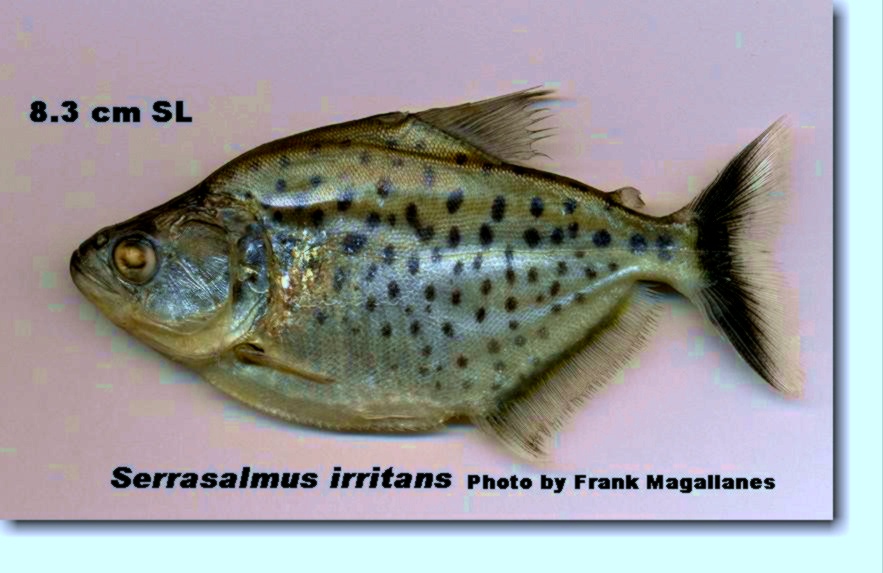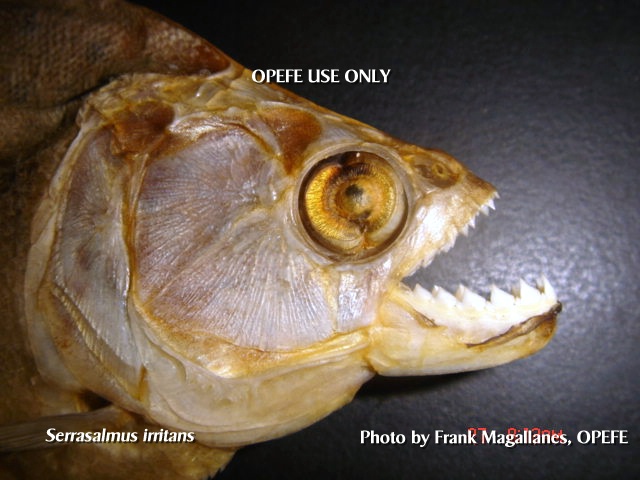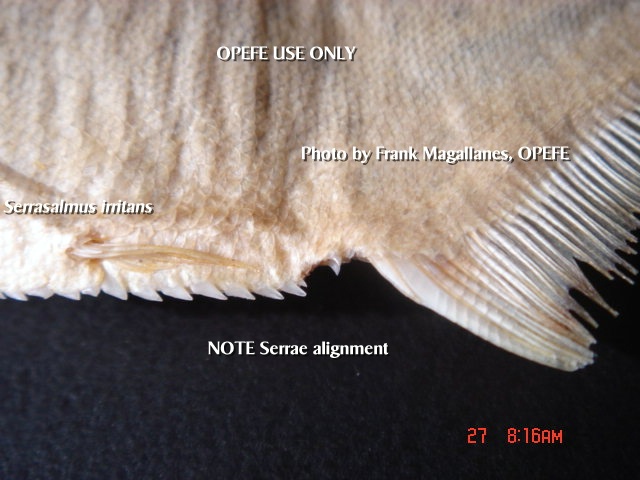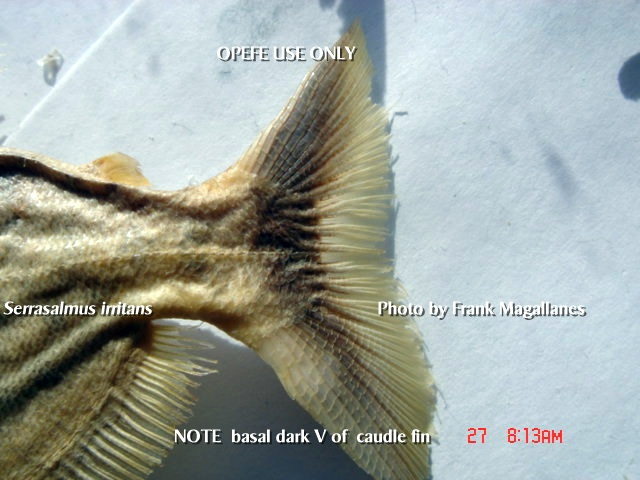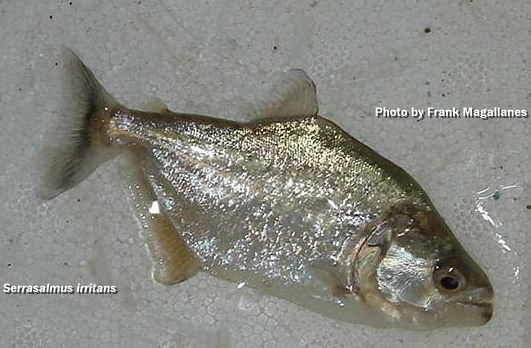From Frank Magallanes
S. irritans formerly classified as S. fernandezi (Fernández-Yépez, 1965), the species is distinctive with its long pointed snout and dark "V" and hyaline border of the caudal fin. The species body is very compressed, rhomboid and is high backed. The species has 5 to 9 ectopterygoid teeth, more evident in juveniles. Vertebrate 34-38, usually 36. Numerous very small scales. The pre-anal spine is very evident on juveniles. (Machado-Allison and Fink, 1996). S. irritans may also be more closely related to S. sanchezi (Peru). Both species share similar morphological appearances. But it will take DNA and a review by a competent authority to validate both species relationship (if any) with each other.
Some aquarists report keeping this species together in large aquariums (100g or more), however, not every situation suggests that this species can be group together in the home aquarium. Pairing this fish with its own species or others could result in severe fin, body damage or death! In the llanos, most Serrasalmus species exhibit high preference for fins during their juvenile and subadult stages. They gradually switch to whole fish as they mature. High rate of fin cropping or damage has been recorded in the field. It remains unknown which species of fish are the primary targets of piranhas. However evidence suggests perciform fishes (Cichlidae) maybe be vulnerable to fin predation by Serrasalmus species. Evidence suggests that cichlids fins may be more nutritious and S. irritans appears to differentiate itself from others by preying most heavily upon fishes having body shapes and habitat preferences most similar to its own Winemiller and Kelso-Winemiller, 1993).
Jeff Concannon has a few years experience keeping piranhas and kept this species in a small group, according to Jeff the grouping of the species went from 5 specimens down to 4 pretty quick (the fish didn't die, just removed). Those 4 survived together for over 1.5 years, growing from about 2 inches to around 4.5 inches. The Oregon heat wave where outside temperatures rose in his garage to105F ended up killing two of his fish. Cause of actual death unknown. Presently in Jeff's aquarium there are 2 fish left that are doing fine together, so far.
LABORATORY EXPERIMENTS WITH FISH ASSEMBLAGES
The predatory behavior of S. irritans is similar to that observed for S. elongatus, except that stalking was observed much more frequently than ambushing (Winemiller and Kelso-Winemiller, 1993). In the assemblage experiment S. irritans were introduced the same artificial environment. The average fin nips recorded per day for S. irritans was 23.5. (Winemiller and Kelso-Winemiller, 1993). S. irritans preyed heavily upon cichlids and to a lesser extent on slow moving, stout-bodied catfishes, such as Pterygoplichthys and Corydoras spp.
COLOR OF LIFE
Live specimens have a bright silver body with numerous small dark spots, diminishing near the ventral area. The ventral area of adults with reddish-orange metallic, while juveniles are silver. The head region is silver with yellow overtones in the lateral region to lateral-ventral area. The iris (orbit) is yellow. The dorsal region is dark.
The anal fin is red to the basal area and some captured specimens have yellow-orange in this area. Old adults have a complete dark, black caudal fin (darkened like a triangle) with a generally hyaline edge, while juveniles form a dark "V" and the end caudal fin hyaline (Machado-Allison and Fink, 1996).
The species S. irritans was compared with the descriptions to bilineatus, brandtii, eigenmanni, elongatus, hollandi and marginatus; with bilineatus differs from irritans by not having the distal caudal band and its proportions; with elongatus the humeral blemish, the high backed body and lateral markings; with hollandi the counts and lateral markings and with marginatus its counts and its dark band at the terminal caudal fin. Mago (1970) and Nico & Taphorn (1986) erroneously placed this species as S. eigenmanni even though this species is also found in Venezuela. The species looks similar to the descriptions pertaining to S. marginatus, S. hollandi and S. eigenmanni in the Amazonas and Guyana, particularly when it pertains to the color and small, numerous spots. The only real difference between irritans and these other species is the morphometric values. Even so, there is exists some confusion with this species. Probably because the morphometric data pertained to small juveniles. Nonetheless, S. irritans (Peters, 1877) seem to be the appropriate name being described from the Rio Apure in Venezuela with abundant collections there and in particular the branches of the Orinoco and los Llanos (Machado, 1996).
BREEDING Serrasalmus irritans
The breeding of this species has not been accomplished by hobbyists. The species seems to be found during the brief, flooded shores, of white and black waters. The juvenile habitat is aquatic plants submerged and floating near the shores or create islands called "bora" that are dragged or migrate during period of heavy rains (flooding). Adults are found in open rivers. Light requirements (moderate) would probably be the same as those found in Llanos of Venezuela. The S. irritans becomes sexually mature sooner than most Serrasalmus species because it is a small species.
Orinoco rivers: pH: 4.5-7 (6.0); 2-8 dH (6); 75-82°F (24-28°C). Because this species has never been bred in captivity, it is my recommendation that a 200 gallon or larger tank be used. Also suggest heavy planting of the tank with a gravel and sand mixed tank be used. Filtration should be moderate (wet/dry system recommended). While this is essentially a small species, I based my conclusion on the "bigger" tank theory because it remains unknown what the minimum tank size would be for such a small species. Water changes, while important is not as important as keeping the water stable and within the parameters suggested above. The area also undergoes a period of a dry season from October - March. The rainy season runs from April - September.
Characiformes usually are visually-oriented diurnal fishes with large eyes; they dwell in well-lit surface waters (Lowe-McConnell 1975, Fink & Fink 1979, Moyle & Cech 1996). In contrast, catfishes are primarily nocturnal and have sensory adaptations (e.g. tactile and chemical receptors) to low visibility (Hara 1971, Lowe-McConnell 1975, Fink & Fink 1979). Another problem with these types of fish is that they are fin biters and you may lose some specimens (due to predation) before anything significant happens in your aquarium. Like the vast majority of piranhas, the breeding process can be very bloody and pieces of flesh or fins will be part of the process. But in the end you will have accomplished a most rare occurrence for the home aquarium.
HISTORICAL NAMES:
-
Serrasalmus fernandezi (Fernández-Yépez)
-
Serrasalmo irritans (Peters, 1877)
DISTRIBUTION
San Fernando Apure, Venezuela. Holotype (unique): ZMB 10045.
MAXIMUM SIZE
13.8 cm SL (5.43307 inches) or 15.0 cm TL (5.90551 inches).
REFERENCES
-
Machado-Allison, Antonio., Fink, William., 1996 Los Peces Caribes de Venezuela, Diagnosis, Claves, Aspectos Ecologicos Y Evolutivos pg. 78-82.
-
Fernández Yépez, A., Un nuevo pez del género «Serrasalmus» colectado en Venezuela. 1965 Evencias. (16):1-4 unnum.
-
Peters, W. (C. H.) 1877 Über die von Dr. C. Sachs in Venezuela gesammelten Fische. Monatsb. Akad. Wiss. Berlin 1877: 469-473. [Published in 1877 [see Bauer et al. 1995:22 [ref. 24410].]
-
Taphorn, D. C. 1992 The characiform fishes of the Apure River drainage, Venezuela. Biollania Edición Especial - No. 4. Monografias Cientificas del Museo de Ciencias Naturales, UNELLEZ -- Guanara, estado Portuguesa, Venezuela. 1-537.
-
Donated preserved specimen by b_ack51 from Piranha-Fury.com, January 15, 2005.
-
Live specimen donated by Jeff Concannon, September 7, 2005,
-
Winemiller, K. O. and Kelso-Winemiller, L. C. Fin-nipping Piranhas, 1993 National Geographic Research & Exploration 9(3): 344-357.
USE YOUR BACKSPACE TO RETURN OR CLICK HERE TO RETURN SERRASALMUS LIST
USE THIS LINK TO RETURN TO RESEARCH PAGE.
TO RETURN HOME CLICK HERE.
The OPEFE web site and its contents; is disclaimed for purposes of Zoological Nomenclature in accordance with the International Code of Zoological Nomenclature, Fourth Edition, Article 8.3 and 8.4. No new names or nomenclature changes are available from statements at this web site.
Copyright© 1994-2012 Oregon Piranha Exotic Fish Exhibit (The OPEFE fish exhibit is permanently CLOSED as of 2000) Sutherlin, Oregon. Information posted on this web site is archival data on fish scientific classifications and other information. DISCLAIMER: The copyrighted material may not be used for any purpose other than private study, scholarship or research. Cited information requires credit and this link www.opefe.com. All rights reserved. All images shown (unless otherwise noted) is property of OPEFE.
UPDATED: 12/26/2011
